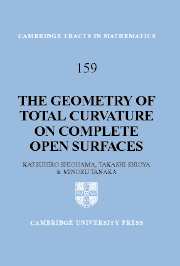Book contents
2 - The classical results of Cohn-Vossen and Huber
Published online by Cambridge University Press: 14 August 2009
Summary
We shall introduce the classical results obtained by Cohn-Vossen in [19] and [20] and Huber in [39] by exhibiting a simpler method under more general assumptions. For this purpose we need to consider the curvature measure over an unbounded domain, not necessarily oriented, with possibly noncompact boundary. The boundary curves may be divergent and hence certain conditions for them will be required. Our ideas will lead to the natural compactification of complete open surfaces for which the Gauss–Bonnet theorem is valid. Some examples on the total curvature of complete open surfaces in R3 are provided. From these examples, one can begin to see the geometric significance of the total curvature of complete open surfaces.
The total curvature of complete open surfaces
From now on let M be a connected, complete and noncompact Riemannian 2-manifold either with or without a piecewise-smooth boundary. In general we cannot expect the Gauss–Bonnet theorem to hold for such an M. However, it is still of interest to consider the Gauss–Bonnet theorem for noncompact surfaces. For this purpose we need to ascertain:
how to define the Euler characteristic of M;
how to make sense of the curvature integral over M.
For point (1) we are led to consider the notion of the finite connectivity of M.
- Type
- Chapter
- Information
- Publisher: Cambridge University PressPrint publication year: 2003



